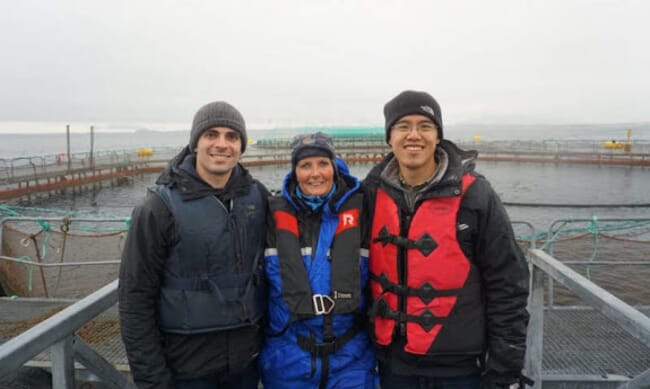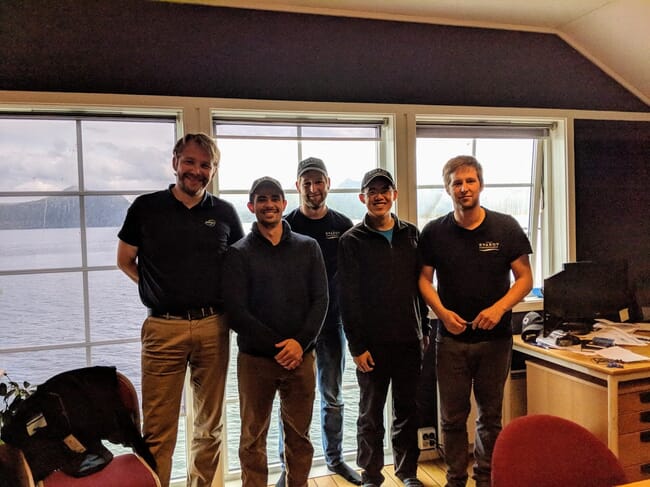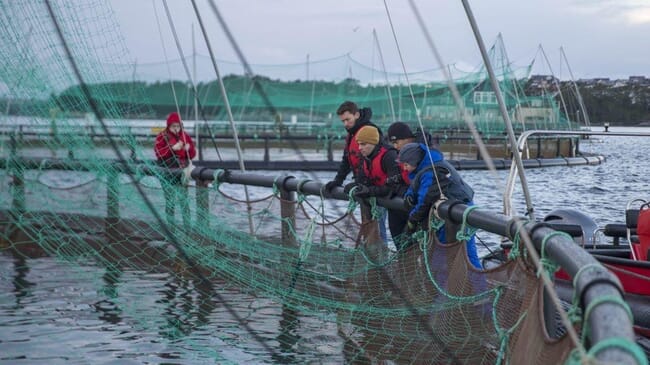While Tony Chen may well be a major player in aquaculture before too long, he admits that he didn’t have a dream start in the world of fish farming. The computer science specialist once tried to rig up his own aquaponics system, with disastrous results.

“Me and my roommates set up an aquaponics project in our basement, but we didn’t have the right equipment, we didn’t have any sensors, and all the fish [goldfish from the local petshop] died,” the MIT graduate confesses.
At the time Chen was developing software for the US government, but he and his friend John Constantino – with whom he went on to found his analytics company Manolin – continued to take an interest in aquaculture.
“We started with aquaponics as a kind of hobby, then we discovered oyster farming in Chesapeake Bay – John and I play a lot of golf and love eating seafood. We met some oyster farmers when we were down there. The farmers’ major concern was what was happening in the water – they didn’t know why their crops would sometimes die off and wanted to develop some way of predicting and understanding diseases and other issues that could arise,” Chen explains.
“We thought it sounded like a problem for big data to solve and we thought, ‘Let’s find some trends and let’s figure out what’s going on.’ But the oyster farmers didn’t have any inventory data to back it up. It was all on pencil and paper and Excel sheets, so they couldn’t collate information to establish patterns to suggest why their oysters were dying,” Chen explains. “So that’s when we really started to understand the aquaculture market and we began writing software for them – building them digital tools to collect data.”
While the software developed by Chen and Constantino may have helped to create a system by which oyster farmers were able to analyse their data, the pair soon realised that to really make an impact they needed to head to an area where aquaculture was booming – and where the farmers were already in the habit of collecting and recording all manner of data.
“We always had this larger vision. We noticed that there were bigger problems in aquaculture, but we needed market access to get into salmon, or other finfish or shrimp – not much happens in the States, so we needed to look elsewhere,” Chen reflects.
He was, at this stage, still working for the US government but a continued interest in seafood led to a chance encounter which persuaded him to turn his hobby into his job.
“We went to the Boston Seafood Show [Seafood Expo North America], where we heard about this aquaculture accelerator called HATCH. They pointed out that our work with oysters could only grow so big, and maybe we should come over to Norway to tackle some of the issues being experienced in salmon,” explains Chen. “We flew to Bergen, saw the ecosystem [ie the salmon-centred business community] and that convinced us it was the right place to build the company, so we quit our jobs and moved halfway round the world.”

The move allowed them access to the salmon farming sector and Chen soon grasped the problems that big-data analysis could help to tackle.
“The main challenge was engaging with the farmers and hearing their issues. Being in Bergen – the centre of salmon aquaculture – and being part of HATCH really helped with this. But the farmers don’t live in Bergen, so it was important to go on a road trip and actually visit them at their sites,” he adds.
“What we’ve identified is that, while so much information is available to the Norwegian farmers, they’re still not getting it fast enough. So we developed a health-response system that notifies farmers when an outbreak is happening, when neighbours have had high sea-lice values, or when they’ve had treatment. It’s really about moving this information a little bit quicker,” Chen explains.
Within five months 19 percent of the Norwegian salmon farmers had agreed to sign up to Manolin’s first platform – quite a feat for an industry that is often described as being deeply conservative.
“John and I pride ourselves in being curious, being humble and asking questions – we’re from a foreign country, we didn’t know anything about salmon and we knew we couldn’t teach them about farming fish – just look at our attempts at aquaponics – but we do understand data and how to build things quickly,” Chen explains.
“We targeted the smaller farms and co-ops first, but now have sites from some of the bigger organisations too,” he adds.
Chen is aware that there’s little point in collecting data purely for the sake of it and is now looking for the best ways to create value for the farmers that use big-data approaches.
“Collecting and moving data is only the first piece. There needs to be action that comes out of it and we’re seeing this in Norway – last fall they enacted the red-light/green-light policy where they divided the country into 13 different zones [according to their lice levels], all in an effort to force the industry to collaborate more towards dealing with some of these health issues. As a company we’ve looked into this data because we wanted to see what the effect of this policy was. It’s only been around for a year but we’ve already seen things happening. In production zone three, which was one of the problem areas… farmers are doing a better job at maintaining low lice values during the critical periods of the year when wild salmon are navigating out to the oceans,” he says.
While on his farm tour he discovered that while having plenty of data to hand helped solve some problems it was also creating others for the farmers.
“While there’s so much data available, it’s hard to aggregate and understand all this information. Even more importantly, it’s really hard to report this information for various sources. Whether it’s certifications, the supply chain or the government, farmers are doing a great deal of paperwork and we thought we could help with that – which led to our second product,” Chen explains. “Farmers were inputting all this data into different systems then – at the end of the month or end of the week – manually aggregating it. What we decided as computer scientists was: let’s just automate this process.”
The end result was that Manolin put together an “ASC dashboard” to help save farmers time. Within two weeks of launch they already have Kvaroy’s five Aquaculture Stewardship Council-certified sites subscribing to the product, which uses the tool to manage their certification paperwork and ensures that the auditing process can be done extremely efficiently.
Looking ahead
However, Chen believes his technical wizardry has the potential to have a much wider impact.
“Our mission is to standardise how the entire industry talks about aquatic health. It starts with helping farmers better understand what’s happening in the area, but that develops into simplified reporting, easier certification, advanced analytics and just a general understanding of what’s happening in our aquatic environment,” he says.
“This can be utilised by the supply chain but, more importantly, I think it’s going to help set better policies for the industry and develop new financing models to stabilise the industry. When you think about the global aquaculture ecosystem, this type of [platform] is, I think, what is necessary for the industry to grow appropriately,” he continues.
As a result, as more and more data are aggregated on Manolin’s system, Chen hopes it will begin to have more tangible benefits for the farmers.
“It’s hard to measure the benefits at the moment, but we’re starting to talk more with companies about more advanced analytics, looking at production stats and modelling some of that. Then we’ll start to look at what value we can really give,” he says.
“That’s why we’ve not charged companies yet – the only thing they have to pay for is the ASC dashboard, and that’s only been turned on in the last couple of weeks,” he explains.

But, despite this relatively modest income stream to date, once he’s captured the data he’s convinced that he will be able to find a product that will start to both create value for the farmers and generate revenue for the company.
“We’re still in the discovery phase but wanted to turn on some revenue streams to showcase the inherent need for our products and the fact that farmers are willing to pay for them,” he says.
“Norway opened our eyes to what’s possible. We see ourselves staying here for the time being – though I think we can do the same other geographies and for other species too, and we do have plans to go international. But it all depends on having access to enough data to be able to add value to the farmers – we found it was harder to add value to the US oyster sector, precisely because of the relative lack of data to aggregate,” Chen reflects.
Funding drive
In order to continue to realise his ambition, Chen is currently “looking to raise $500,000 over the next few months – to scale up our team and continue hitting our milestones to help aquaculture grow”.
And he hopes to attract two quite different types of investors.
“We’re really looking for value-added investors. On one side we want more access to Norway, so we’re looking for investors who’ve been in the industry and have a bit more industry knowledge. At the same time, as a tech company, we want to grow quickly so we’d love to go to the US tech scene to look for advisors and mentors for how we can scale up a tech business quickly. The combination would position us well for global growth,” he concludes.



